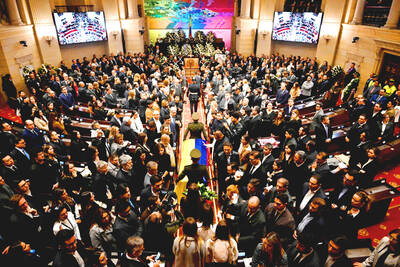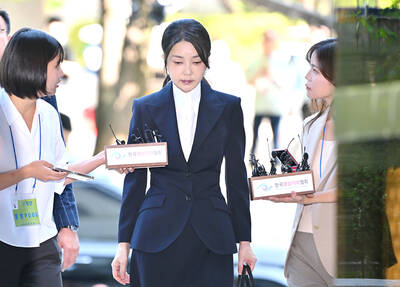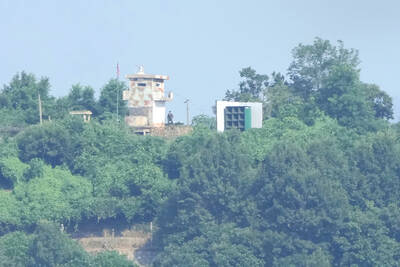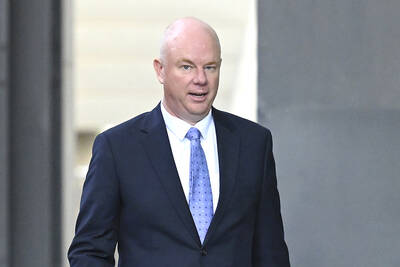Major arms exporter South Korea is not ruling out providing weapons directly to Ukraine, South Korean President Yoon Suk-yeol said yesterday, signaling a possible shift in Seoul’s stance on the issue.
Yoon also said he had discussed North Korea with US president-elect Donald Trump in a phone conversation that laid the groundwork for a meeting in the “near future.”
South Korea has a long-standing policy of not providing weapons to countries in conflict, but indicated that could change in light of Pyongyang’s deployment of troops to Russia to aid its war efforts in Ukraine.
“Now, depending on the level of North Korean involvement, we will gradually adjust our support strategy in phases,” Yoon said at a news conference in Seoul.
“This means we are not ruling out the possibility of providing weapons,” he added.
North Korea has become one of the most vocal and important backers of Russia’s full-scale offensive in Ukraine.
Seoul and the West have long accused Pyongyang of supplying artillery shells and missiles to Moscow for use in Ukraine.
The South Korean National Intelligence Service said the North has deployed about 10,000 troops to Russia, suggesting even deeper involvement in the conflict and triggering an outcry and warnings in Seoul, Kyiv, and Western capitals.
Yoon said his office would monitor unfolding developments related to the operations of North Korean soldiers, and if he decided to provide weapons to Kyiv, the initial batch would be defensive.
“If we proceed with weapons support, we would prioritize defensive weapons as a first consideration,” he said without elaborating further.
In a call with Trump that took place before the press briefing, Yoon said the two men had discussed a number of issues surrounding North Korea while agreeing to a face-to-face meeting.
“We agreed to meet in the near future… I believe there will be an opportunity to meet within this year,” Yoon said.
Among the topics discussed were recent moves by the North, including its sending of trash-carrying balloons southward, he said.
“Regarding North Korea, we addressed issues such as the launching of more than 7,000 trash balloons, GPS jamming, and their indiscriminate firing of ICBMs, IRBMs and SRBMs,” Yoon said, referring to a recent flurry of missile tests.
Compared with his dovish predecessor, former South Korea president Moon Jae-in, Yoon has taken a tough stance with the nuclear-armed North while improving ties with security ally Washington.
Since North Korean leader Kim Jong-un’s second summit with then-US president Trump collapsed in Hanoi in 2019, Pyongyang has abandoned diplomacy, doubling down on weapons development and rejecting Washington’s offers of talks.
While in office, Trump met with Kim three times, beginning with a landmark summit in Singapore in June 2018, although the pair failed to make much progress on efforts to denuclearize the North.
During the campaign, Trump said: “I think he misses me,” and that it was “nice to get along with somebody that has a lot of nuclear weapons.”
In a commentary released in July, North Korea said that while it was true Trump tried to reflect the “special personal relations” between the heads of states, he “did not bring about any substantial positive change.”

‘THEY KILLED HOPE’: Four presidential candidates were killed in the 1980s and 1990s, and Miguel Uribe’s mother died during a police raid to free her from Pablo Escobar Colombian presidential candidate Miguel Uribe has died two months after being shot at a campaign rally, his family said on Monday, as the attack rekindled fears of a return to the nation’s violent past. The 39-year-old conservative senator, a grandson of former Colombian president Julio Cesar Turbay (1978-1982), was shot in the head and leg on June 7 at a rally in the capital, Bogota, by a suspected 15-year-old hitman. Despite signs of progress in the past few weeks, his doctors on Saturday announced he had a new brain hemorrhage. “To break up a family is the most horrific act of violence that

HISTORIC: After the arrest of Kim Keon-hee on financial and political funding charges, the country has for the first time a former president and former first lady behind bars South Korean prosecutors yesterday raided the headquarters of the former party of jailed former South Korean president Yoon Suk-yeol to gather evidence in an election meddling case against his wife, a day after she was arrested on corruption and other charges. Former first lady Kim Keon-hee was arrested late on Tuesday on a range of charges including stock manipulation and corruption, prosecutors said. Her arrest came hours after the Seoul Central District Court reviewed prosecutors’ request for an arrest warrant against the 52-year-old. The court granted the warrant, citing the risk of tampering with evidence, after prosecutors submitted an 848-page opinion laying out

North Korean troops have started removing propaganda loudspeakers used to blare unsettling noises along the border, South Korea’s military said on Saturday, days after Seoul’s new administration dismantled ones on its side of the frontier. The two countries had already halted propaganda broadcasts along the demilitarized zone, Seoul’s military said in June after the election of South Korean President Lee Jae-myung, who is seeking to ease tensions with Pyongyang. The South Korean Ministry of National Defense on Monday last week said it had begun removing loudspeakers from its side of the border as “a practical measure aimed at helping ease

DEADLY TASTE TEST: Erin Patterson tried to kill her estranged husband three times, police said in one of the major claims not heard during her initial trial Australia’s recently convicted mushroom murderer also tried to poison her husband with bolognese pasta and chicken korma curry, according to testimony aired yesterday after a suppression order lapsed. Home cook Erin Patterson was found guilty last month of murdering her husband’s parents and elderly aunt in 2023, lacing their beef Wellington lunch with lethal death cap mushrooms. A series of potentially damning allegations about Patterson’s behavior in the lead-up to the meal were withheld from the jury to give the mother-of-two a fair trial. Supreme Court Justice Christopher Beale yesterday rejected an application to keep these allegations secret. Patterson tried to kill her